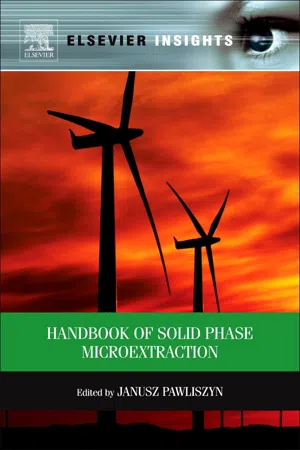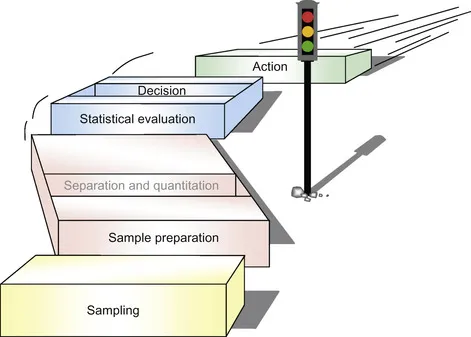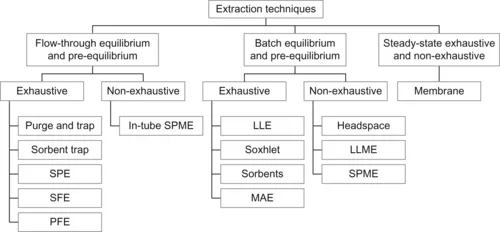1.1. Sample Preparation as Part of the Analytical Process
The analytical procedure for complex samples consists of several steps that typically include sampling, sample preparation, separation, quantitation, statistical evaluation and decision making (Figure 1.1).
Each step is critical for obtaining correct and informative results. The sampling step includes deciding where to get samples that properly define the object or problem being characterised and then choosing a method to obtain samples in the right amounts. The objective of the sample preparation step is to isolate the components of interest from a sample matrix. This is because most analytical instruments cannot handle the matrix directly. Sample preparation involves extraction procedures and can also include ‘clean-up’ procedures for very complex ‘dirty’ samples. This step must also bring the analytes to a suitable concentration level for detection; therefore, sample preparation methods typically include enrichment. During the separation step of the analytical process, the isolated complex mixture containing target analytes is divided into its constituents, typically by means of chromatographic or electrophoretic techniques. Quantitation is the determination of amounts of the identified compounds. The identification can be based on a retention time combined with selective detection; more frequently, however, instruments providing more specific information (namely, mass spectrometers) are used to eliminate possible errors in quantification due to interferences. Statistical evaluation of the results provides an estimate of the target compound’s concentration in the sample being analysed. The data will then support appropriate decisions, which might include taking another sample for further investigation.
It is important to note, as emphasised in Figure 1.1, that analytical steps follow one after the other, and a subsequent step cannot begin until the preceding one has been completed. Therefore, the slowest step determines the overall speed of the analytical process, and improving the speed of a single step may not result in a throughput increase. To increase the throughput of analysis, all steps need to be considered. Also, errors performed in any preceding step, including sampling, will result in the overall poor performance of the procedure.
There have been major breakthroughs in the development of improved instrumentation, which involve miniaturisation of analytical devices and hyphenation of different steps into one system. It is recognised that an ideal instrument would perform all the analytical steps without human intervention, preferably directly on the site where an investigated system is located rather than moving the sample to the laboratory, as is currently done. This approach would eliminate the errors and the time associated with sample transport and storage and result in more accurate, more precise and faster production of analytical data. Although such a total analysis system (TAS) is challenging to build, today’s sophisticated instruments, such as the gas chromatograph/mass spectrometer (GC–MS) or liquid chromatograph/mass spectrometer (LC–MS), can separate and quantify complex mixtures and automatically apply chemometric methods to evaluate results statistically. It is much more difficult to hyphenate sampling and sample preparation steps, primarily because the current state of the art in sample preparation techniques employs multistep procedures involving organic solvents. These characteristics make it difficult to develop a method that integrates sampling and sample preparation with separation methods for the purposes of automation. The result is that more than 80% of analysis time is currently spent on sampling and sample preparation steps.
One of the reasons that progress in the area of sample preparation is so slow is that the fundamentals of extraction involving natural, frequently complex samples are much less developed and understood compared to physicochemically simpler systems used in separation and quantification steps, such as chromatography and mass spectrometry. This situation creates an impression that rational design and optimisation of extraction systems is not possible. Therefore, development of sample preparation procedures is frequently considered to be ‘art’, not ‘science’.
This situation creates a tendency by practitioners and regulatory agencies to prefer exhaustive over non-exhaustive techniques (Figure 1.2), even though this choice frequently results in labour-intensive and costly procedures. The main objective of the exhaustive techniques is to remove analytes completely from a sample matrix and transfer them to the extraction phase. The fundamental advantage of exhaustive methods is that, in principle, they do not require calibration because the vast majority of analytes are transferred to the extraction phase. There are alternative extraction techniques, however, with their own unique advantages, which have been developed to reduce solvent use and improve performance. A summary of extraction techniques is given below.
1.2. Classification of Extraction Techniques
Figure 1.2 provides a classification of extraction techniques and unifies the fundamental principles behind the different extraction approaches. In principle, exhaustive extraction approaches do not require calibration because most analytes are transferred to the extraction phase by employing overwhelming amounts of it. In practice, however, confirmation of satisfactory recoveries is implemented in the method by using surrogate standards. To reduce the amounts of solvents and time required to accomplish exhaustive removal, batch equilibrium techniques (e.g. liquid–liquid extractions) are frequently replaced by flow-through techniques.
For example, a sorbent bed can be packed with the extraction phase dispersed on a supporting material; when a sample is passed through, the analytes in the sample are retained on the bed. Large volumes of sample can be passed through a small cartridge, and the flow through the well-packed bed facilitates efficient mass transfer. The extraction procedure is followed by desorption of analytes into a small volume of solvent, resulting in substantial enrichment and concentration of the analytes. This strategy is used in sorbent-trap techniques and in solid-phase extraction (SPE). 1 Alternatively, sample (typically a solid sample) can be packed in the bed and the extraction phase can be used to remove and transport the analytes to the collection point. In supercritical fluid extraction, compressed gas is used to wash analytes from the sample matrix; an inert gas at atmospheric pressure performs the same function in purge-and-trap methods. For example, in dynamic solvent extraction in a Soxhlet apparatus, the solvent continuously removes the analytes from the matrix at the boiling point of the solvent. In more recent pressurised fluid extraction techniques, smaller volumes of organic solvent (or even water) are used to achieve greater enrichment at the same time as extraction because of the solvent’s increased capacity and elution strength at high temperatures and pressures. 2
Alternatively, non-exhaustive approaches can be designed on the basis of the principles of equilibrium, pre-equilibrium and permeation. 3 Although equilibrium non-exhaustive techniques are fundamentally analogous to equilibrium-exhaustive techniques, the capacity of the extraction phase is smaller and is usually insufficient to remove most of the analytes from the sample matrix. This is because a small volume of the extracting phase is being used relative to the sample volume, such as is employed in microextraction [solvent microextraction4 or solid-phase microextraction (SPME5)] or a low sample matrix–extraction phase distribution constant, as is typically encountered in gaseous headspace techniques. 6
Pre-equilibrium conditions are accomplished by breaking the contact between the extraction phase and the sample matrix before equilibrium with the extracting phase has been reached. Although the devices used are frequently identical to those of microextraction systems, shorter extraction times are employed. The pre-equilibrium approach is conceptually similar to the flow-injection analysis (FIA) approach, 7 in which quantification is performed in a dynamic system and system equilibrium is not required to obtain acceptable levels of sensitivity, reproducibility and accuracy. In permeation techniques, e.g. membrane extraction, 8 continuous steady-state transport of analytes through the extraction phase is accomplished by simultaneous re-extraction of analytes. Membrane extraction can be made exhaustive by designing appropriate membrane modules and optimising the sample and stripping flow conditions, 9 or it can be optimised for throughput and sensitivity in non-exhaustive, open-bed extraction. 10 Because membrane extr...


